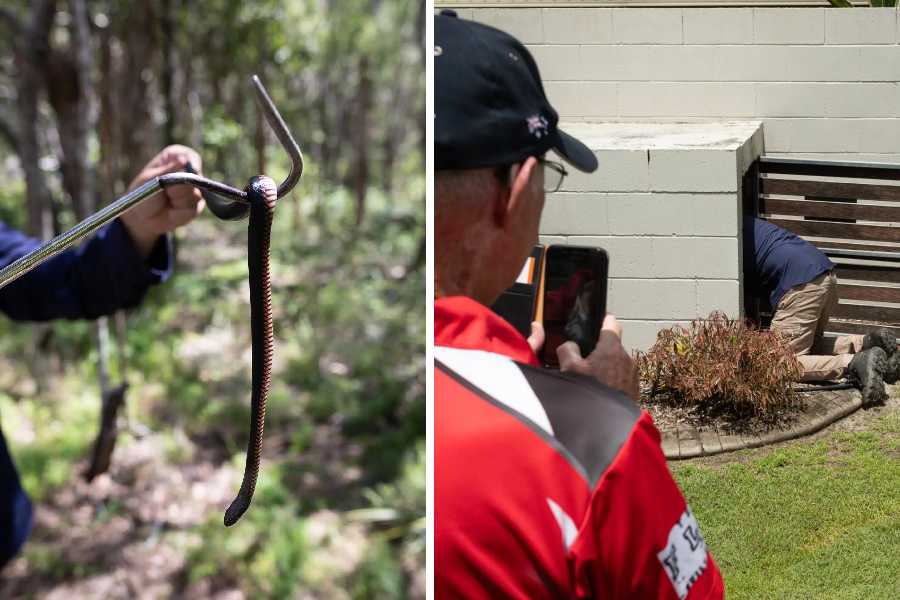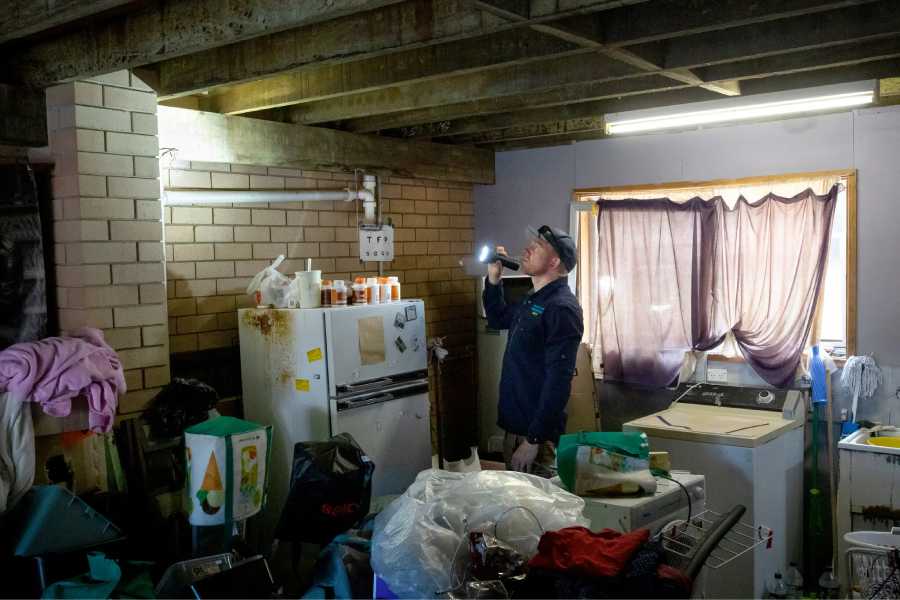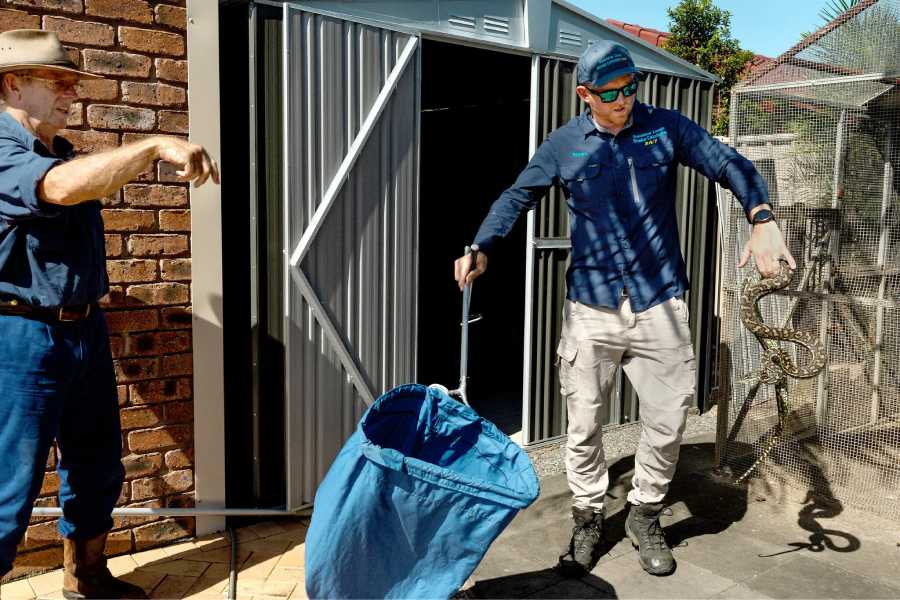The phone rings. It’s the local prison. There’s a snake in a cell. Within a few hours, snakes have also been spotted at a school, beneath a piano stored in a private garage and near a lagoon-like swimming pool at a retirement home. Customers want them gone.
Business has never been so good for Stuart McKenzie, who runs a snake-catching service in the Sunshine Coast, a verdant enclave along miles of pristine beach in the vast Australian state of Queensland. On the busiest days, he can receive more than 35 calls about troublesome snakes.
Queensland is home to the largest number of snake species in Australia — about 120. Of those, two-thirds are venomous and a handful are deadly. Throughout Australia, fatalities from snake bites remain extremely rare — about two a year — and in Queensland, the reptiles are simply a part of life.

A venomous red-bellied black snake captured at a resort being released in native bush land (L)/ Mr. McKenzie searching for a snake at a retirement village, while people look on and film him (R) David Maurice Smith for The New York Times
In the cooler months of the year — historically from April to September — snakes become sluggish and may not eat, drink, defecate or even move for weeks at a time. But as the world warms and the climate in southern Queensland shifts from subtropical to tropical, this period of brumation is shrinking — meaning more run-ins between humans and the animals.
“Not only are snakes becoming more active earlier in the year and staying active longer in the year, but it also means that they’re going to stay active longer into the night,” said Bryan Fry, a professor of biology at the University of Queensland. On nights with temperatures above about 28 or 29 degrees Celsius, or 82 degrees Fahrenheit, he added, snakes will remain active all night long.
McKenzie, 35, of Sunshine Coast Snake Catchers 24/7, says his winter break is getting shorter and shorter.
On one recent job, a 4-foot brown snake — the world’s second-most venomous snake species, despite the understated name — was wedged between a fly screen and a window, and needed to be taken out. More straightforward was a request to remove a nonvenomous carpet python, its body intricately patterned with whorls and swirls, coiled in the depths of a shed. (Snake removal fees start at 154 Australian dollars, or around $100.)
Snake catchers travel light. On a typical job, they may carry little more than a metal hook, used to gently prod a snake out from under furniture or push it into place, and a large cotton bag into which snakes are relocated. In every job, the aim is to harm or disrupt the snake as little as possible — and then to bring it somewhere it is less likely to run into trouble.
With the population of the Sunshine Coast projected to increase more than 50% to about half a million people in the 25 years to 2041, deforestation is happening at speed. More housing is being built, and many snakes who once dwelled in native bush land are finding sanctuary — and a reliable source of food and water — in homes intended for humans.

Mr. McKenzie on the hunt for a snake in a home David Maurice Smith for The New York Times
Most run-ins are without incident. But fear and misinformation still proliferate, McKenzie said, as well as lingering perceptions among older generations of Australians that “the only good snake is a dead snake.”
McKenzie can catch highly venomous reptiles with his bare hands and a balletic fluidity. But he must also be almost as nimble to wrangle the humans. Customers can be intensely afraid of snakes, and if passersby see him releasing a healthy specimen into the wild after it has been removed from a home, they may respond with fear, rage or tears.
Like kangaroos, koalas and other Australian wildlife, snakes are protected under law, and they play a critical role in the ecosystem by keeping pests at bay. Researchers from Macquarie University found that by eating mice and rats, snakes’ benefits to farmers far outweigh the potential costs of having a venomous creature on site.
As a small and harmless tree snake was removed from her bedroom, Doris Hyde, 96, explained how she had panicked and, on instinct, hit the animal with a jet of fly spray. “I thought it might make it sick,” she said.
“You mustn’t do that,” McKenzie said, because it could injure the animal. “Next time, just call us,” he added, as he rinsed off the creature under the kitchen faucet.
For every snake that can be peaceably placed in a bag and taken far away, there are many more that vanish before a snake catcher can even arrive. On one such fruitless job, McKenzie strode through some bushes near a retirement home, pushing foliage to one side and looking deep into an outhouse by the pool. The sun beat down, and he lifted an arm to wipe his brow.

Mr. McKenzie holding a small harmless tree snake he caught at the home of Doris Hyde. She had panicked and hit the animal with a jet of fly spray (L)/ Mr. McKenzie, with Dan Rumsey of Sunshine Coast Snake Catchers, inspecting a tree snake that has been attacked by a house cat, to decide whether it is fit for release (R) David Maurice Smith for The New York Times
“Just long, sweaty days,” he said, “chasing extremely dangerous snakes.”
Unwell snakes receive care at the nearby Australia Zoo, founded by conservationist Steve Irwin. On a recent Thursday, McKenzie brought three injured pythons to the clinic. Two accepted an inspection with relative grace, but the third lashed across the floor, motioning its head as if to bite McKenzie’s left knee as he held its tail steady in his hand.
“He’s a cranky-pants,” said Katie Whittle, the veterinarian.
McKenzie’s business has appeared on local television, and it has a substantial social media following on TikTok, Instagram and Facebook, with posts of videos and pictures of snakes eating improbably large possums, hanging out in places they shouldn’t be and generally getting into ophidian mischief.
McKenzie, who employs a social media manager to maintain a rigorous posting schedule, attempts to strike a balance between “nice, easy carpet python catches,” he said, “and defensive brown snake scary catches” to dissuade people from trying to handle snakes themselves without proper training.
In his current job for the past seven years, McKenzie previously worked as a reptile handler at the Australia Zoo. Since childhood, he has had blue-tongued lizards as pets, but he was initially wary of snakes and had little interest in handling them. Only after working with them every day at the zoo, he said, did he think: “Geez, these things are actually really cool.”
In recent years, his business has expanded to include seven snake catchers and dozens of subcontractors across Queensland. Still, the hours can be relentless.
“It’s one of those jobs that can take a toll,” he said.
The New York Times News Service











